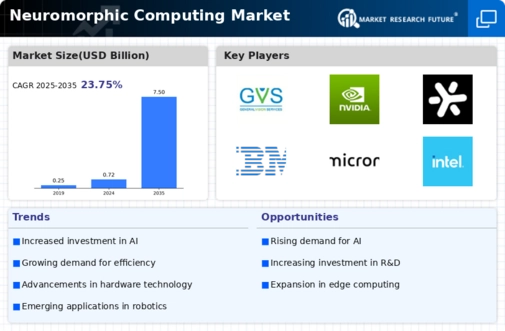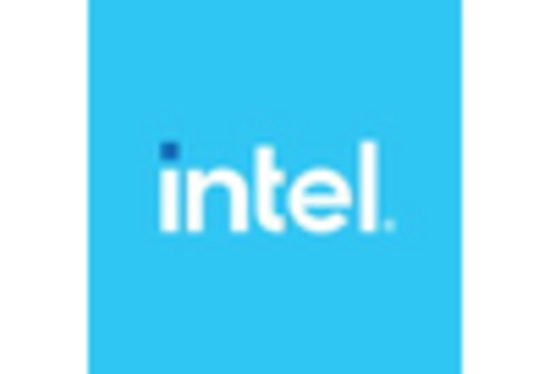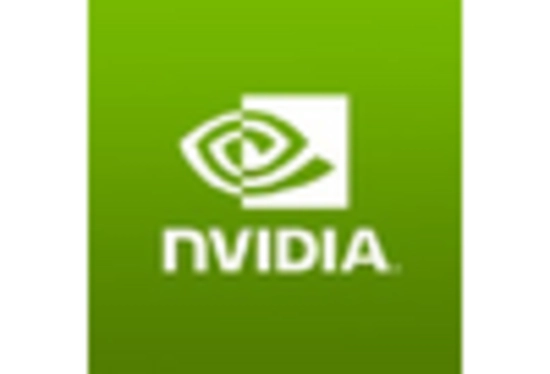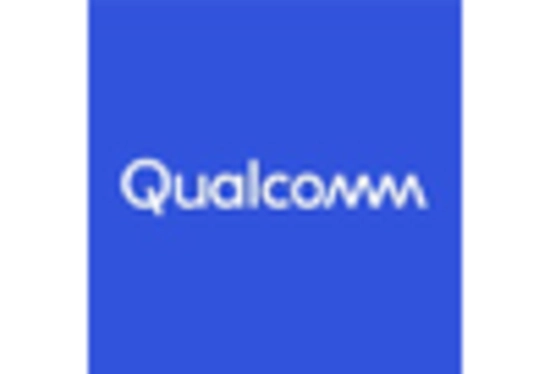Analog Neuromorphic Computing
Digital Neuromorphic Computing
Hybrid Neuromorphic Computing
Robotics
Natural Language Processing
Computer Vision
Automotive Applications
Consumer Electronics
Healthcare
Aerospace and Defense
Industrial Automation
Hardware
Software
Services
North America
Europe
South America
Asia Pacific
Middle East and Africa
North America Outlook (USD Billion, 2019-2035)
North America Neuromorphic Computing Market by Technology Type
Analog Neuromorphic Computing
Digital Neuromorphic Computing
Hybrid Neuromorphic Computing
North America Neuromorphic Computing Market by Application Type
Robotics
Natural Language Processing
Computer Vision
Automotive Applications
North America Neuromorphic Computing Market by End Use Type
Consumer Electronics
Healthcare
Aerospace and Defense
Industrial Automation
North America Neuromorphic Computing Market by Component Type
Hardware
Software
Services
North America Neuromorphic Computing Market by Regional Type
US
Canada
US Outlook (USD Billion, 2019-2035)
US Neuromorphic Computing Market by Technology Type
Analog Neuromorphic Computing
Digital Neuromorphic Computing
Hybrid Neuromorphic Computing
US Neuromorphic Computing Market by Application Type
Robotics
Natural Language Processing
Computer Vision
Automotive Applications
US Neuromorphic Computing Market by End Use Type
Consumer Electronics
Healthcare
Aerospace and Defense
Industrial Automation
US Neuromorphic Computing Market by Component Type
Hardware
Software
Services
CANADA Outlook (USD Billion, 2019-2035)
CANADA Neuromorphic Computing Market by Technology Type
Analog Neuromorphic Computing
Digital Neuromorphic Computing
Hybrid Neuromorphic Computing
CANADA Neuromorphic Computing Market by Application Type
Robotics
Natural Language Processing
Computer Vision
Automotive Applications
CANADA Neuromorphic Computing Market by End Use Type
Consumer Electronics
Healthcare
Aerospace and Defense
Industrial Automation
CANADA Neuromorphic Computing Market by Component Type
Hardware
Software
Services
Europe Outlook (USD Billion, 2019-2035)
Europe Neuromorphic Computing Market by Technology Type
Analog Neuromorphic Computing
Digital Neuromorphic Computing
Hybrid Neuromorphic Computing
Europe Neuromorphic Computing Market by Application Type
Robotics
Natural Language Processing
Computer Vision
Automotive Applications
Europe Neuromorphic Computing Market by End Use Type
Consumer Electronics
Healthcare
Aerospace and Defense
Industrial Automation
Europe Neuromorphic Computing Market by Component Type
Hardware
Software
Services
Europe Neuromorphic Computing Market by Regional Type
Germany
UK
France
Russia
Italy
Spain
Rest of Europe
GERMANY Outlook (USD Billion, 2019-2035)
GERMANY Neuromorphic Computing Market by Technology Type
Analog Neuromorphic Computing
Digital Neuromorphic Computing
Hybrid Neuromorphic Computing
GERMANY Neuromorphic Computing Market by Application Type
Robotics
Natural Language Processing
Computer Vision
Automotive Applications
GERMANY Neuromorphic Computing Market by End Use Type
Consumer Electronics
Healthcare
Aerospace and Defense
Industrial Automation
GERMANY Neuromorphic Computing Market by Component Type
Hardware
Software
Services
UK Outlook (USD Billion, 2019-2035)
UK Neuromorphic Computing Market by Technology Type
Analog Neuromorphic Computing
Digital Neuromorphic Computing
Hybrid Neuromorphic Computing
UK Neuromorphic Computing Market by Application Type
Robotics
Natural Language Processing
Computer Vision
Automotive Applications
UK Neuromorphic Computing Market by End Use Type
Consumer Electronics
Healthcare
Aerospace and Defense
Industrial Automation
UK Neuromorphic Computing Market by Component Type
Hardware
Software
Services
FRANCE Outlook (USD Billion, 2019-2035)
FRANCE Neuromorphic Computing Market by Technology Type
Analog Neuromorphic Computing
Digital Neuromorphic Computing
Hybrid Neuromorphic Computing
FRANCE Neuromorphic Computing Market by Application Type
Robotics
Natural Language Processing
Computer Vision
Automotive Applications
FRANCE Neuromorphic Computing Market by End Use Type
Consumer Electronics
Healthcare
Aerospace and Defense
Industrial Automation
FRANCE Neuromorphic Computing Market by Component Type
Hardware
Software
Services
RUSSIA Outlook (USD Billion, 2019-2035)
RUSSIA Neuromorphic Computing Market by Technology Type
Analog Neuromorphic Computing
Digital Neuromorphic Computing
Hybrid Neuromorphic Computing
RUSSIA Neuromorphic Computing Market by Application Type
Robotics
Natural Language Processing
Computer Vision
Automotive Applications
RUSSIA Neuromorphic Computing Market by End Use Type
Consumer Electronics
Healthcare
Aerospace and Defense
Industrial Automation
RUSSIA Neuromorphic Computing Market by Component Type
Hardware
Software
Services
ITALY Outlook (USD Billion, 2019-2035)
ITALY Neuromorphic Computing Market by Technology Type
Analog Neuromorphic Computing
Digital Neuromorphic Computing
Hybrid Neuromorphic Computing
ITALY Neuromorphic Computing Market by Application Type
Robotics
Natural Language Processing
Computer Vision
Automotive Applications
ITALY Neuromorphic Computing Market by End Use Type
Consumer Electronics
Healthcare
Aerospace and Defense
Industrial Automation
ITALY Neuromorphic Computing Market by Component Type
Hardware
Software
Services
SPAIN Outlook (USD Billion, 2019-2035)
SPAIN Neuromorphic Computing Market by Technology Type
Analog Neuromorphic Computing
Digital Neuromorphic Computing
Hybrid Neuromorphic Computing
SPAIN Neuromorphic Computing Market by Application Type
Robotics
Natural Language Processing
Computer Vision
Automotive Applications
SPAIN Neuromorphic Computing Market by End Use Type
Consumer Electronics
Healthcare
Aerospace and Defense
Industrial Automation
SPAIN Neuromorphic Computing Market by Component Type
Hardware
Software
Services
REST OF EUROPE Outlook (USD Billion, 2019-2035)
REST OF EUROPE Neuromorphic Computing Market by Technology Type
Analog Neuromorphic Computing
Digital Neuromorphic Computing
Hybrid Neuromorphic Computing
REST OF EUROPE Neuromorphic Computing Market by Application Type
Robotics
Natural Language Processing
Computer Vision
Automotive Applications
REST OF EUROPE Neuromorphic Computing Market by End Use Type
Consumer Electronics
Healthcare
Aerospace and Defense
Industrial Automation
REST OF EUROPE Neuromorphic Computing Market by Component Type
Hardware
Software
Services
APAC Outlook (USD Billion, 2019-2035)
APAC Neuromorphic Computing Market by Technology Type
Analog Neuromorphic Computing
Digital Neuromorphic Computing
Hybrid Neuromorphic Computing
APAC Neuromorphic Computing Market by Application Type
Robotics
Natural Language Processing
Computer Vision
Automotive Applications
APAC Neuromorphic Computing Market by End Use Type
Consumer Electronics
Healthcare
Aerospace and Defense
Industrial Automation
APAC Neuromorphic Computing Market by Component Type
Hardware
Software
Services
APAC Neuromorphic Computing Market by Regional Type
China
India
Japan
South Korea
Malaysia
Thailand
Indonesia
Rest of APAC
CHINA Outlook (USD Billion, 2019-2035)
CHINA Neuromorphic Computing Market by Technology Type
Analog Neuromorphic Computing
Digital Neuromorphic Computing
Hybrid Neuromorphic Computing
CHINA Neuromorphic Computing Market by Application Type
Robotics
Natural Language Processing
Computer Vision
Automotive Applications
CHINA Neuromorphic Computing Market by End Use Type
Consumer Electronics
Healthcare
Aerospace and Defense
Industrial Automation
CHINA Neuromorphic Computing Market by Component Type
Hardware
Software
Services
INDIA Outlook (USD Billion, 2019-2035)
INDIA Neuromorphic Computing Market by Technology Type
Analog Neuromorphic Computing
Digital Neuromorphic Computing
Hybrid Neuromorphic Computing
INDIA Neuromorphic Computing Market by Application Type
Robotics
Natural Language Processing
Computer Vision
Automotive Applications
INDIA Neuromorphic Computing Market by End Use Type
Consumer Electronics
Healthcare
Aerospace and Defense
Industrial Automation
INDIA Neuromorphic Computing Market by Component Type
Hardware
Software
Services
JAPAN Outlook (USD Billion, 2019-2035)
JAPAN Neuromorphic Computing Market by Technology Type
Analog Neuromorphic Computing
Digital Neuromorphic Computing
Hybrid Neuromorphic Computing
JAPAN Neuromorphic Computing Market by Application Type
Robotics
Natural Language Processing
Computer Vision
Automotive Applications
JAPAN Neuromorphic Computing Market by End Use Type
Consumer Electronics
Healthcare
Aerospace and Defense
Industrial Automation
JAPAN Neuromorphic Computing Market by Component Type
Hardware
Software
Services
SOUTH KOREA Outlook (USD Billion, 2019-2035)
SOUTH KOREA Neuromorphic Computing Market by Technology Type
Analog Neuromorphic Computing
Digital Neuromorphic Computing
Hybrid Neuromorphic Computing
SOUTH KOREA Neuromorphic Computing Market by Application Type
Robotics
Natural Language Processing
Computer Vision
Automotive Applications
SOUTH KOREA Neuromorphic Computing Market by End Use Type
Consumer Electronics
Healthcare
Aerospace and Defense
Industrial Automation
SOUTH KOREA Neuromorphic Computing Market by Component Type
Hardware
Software
Services
MALAYSIA Outlook (USD Billion, 2019-2035)
MALAYSIA Neuromorphic Computing Market by Technology Type
Analog Neuromorphic Computing
Digital Neuromorphic Computing
Hybrid Neuromorphic Computing
MALAYSIA Neuromorphic Computing Market by Application Type
Robotics
Natural Language Processing
Computer Vision
Automotive Applications
MALAYSIA Neuromorphic Computing Market by End Use Type
Consumer Electronics
Healthcare
Aerospace and Defense
Industrial Automation
MALAYSIA Neuromorphic Computing Market by Component Type
Hardware
Software
Services
THAILAND Outlook (USD Billion, 2019-2035)
THAILAND Neuromorphic Computing Market by Technology Type
Analog Neuromorphic Computing
Digital Neuromorphic Computing
Hybrid Neuromorphic Computing
THAILAND Neuromorphic Computing Market by Application Type
Robotics
Natural Language Processing
Computer Vision
Automotive Applications
THAILAND Neuromorphic Computing Market by End Use Type
Consumer Electronics
Healthcare
Aerospace and Defense
Industrial Automation
THAILAND Neuromorphic Computing Market by Component Type
Hardware
Software
Services
INDONESIA Outlook (USD Billion, 2019-2035)
INDONESIA Neuromorphic Computing Market by Technology Type
Analog Neuromorphic Computing
Digital Neuromorphic Computing
Hybrid Neuromorphic Computing
INDONESIA Neuromorphic Computing Market by Application Type
Robotics
Natural Language Processing
Computer Vision
Automotive Applications
INDONESIA Neuromorphic Computing Market by End Use Type
Consumer Electronics
Healthcare
Aerospace and Defense
Industrial Automation
INDONESIA Neuromorphic Computing Market by Component Type
Hardware
Software
Services
REST OF APAC Outlook (USD Billion, 2019-2035)
REST OF APAC Neuromorphic Computing Market by Technology Type
Analog Neuromorphic Computing
Digital Neuromorphic Computing
Hybrid Neuromorphic Computing
REST OF APAC Neuromorphic Computing Market by Application Type
Robotics
Natural Language Processing
Computer Vision
Automotive Applications
REST OF APAC Neuromorphic Computing Market by End Use Type
Consumer Electronics
Healthcare
Aerospace and Defense
Industrial Automation
REST OF APAC Neuromorphic Computing Market by Component Type
Hardware
Software
Services
South America Outlook (USD Billion, 2019-2035)
South America Neuromorphic Computing Market by Technology Type
Analog Neuromorphic Computing
Digital Neuromorphic Computing
Hybrid Neuromorphic Computing
South America Neuromorphic Computing Market by Application Type
Robotics
Natural Language Processing
Computer Vision
Automotive Applications
South America Neuromorphic Computing Market by End Use Type
Consumer Electronics
Healthcare
Aerospace and Defense
Industrial Automation
South America Neuromorphic Computing Market by Component Type
Hardware
Software
Services
South America Neuromorphic Computing Market by Regional Type
Brazil
Mexico
Argentina
Rest of South America
BRAZIL Outlook (USD Billion, 2019-2035)
BRAZIL Neuromorphic Computing Market by Technology Type
Analog Neuromorphic Computing
Digital Neuromorphic Computing
Hybrid Neuromorphic Computing
BRAZIL Neuromorphic Computing Market by Application Type
Robotics
Natural Language Processing
Computer Vision
Automotive Applications
BRAZIL Neuromorphic Computing Market by End Use Type
Consumer Electronics
Healthcare
Aerospace and Defense
Industrial Automation
BRAZIL Neuromorphic Computing Market by Component Type
Hardware
Software
Services
MEXICO Outlook (USD Billion, 2019-2035)
MEXICO Neuromorphic Computing Market by Technology Type
Analog Neuromorphic Computing
Digital Neuromorphic Computing
Hybrid Neuromorphic Computing
MEXICO Neuromorphic Computing Market by Application Type
Robotics
Natural Language Processing
Computer Vision
Automotive Applications
MEXICO Neuromorphic Computing Market by End Use Type
Consumer Electronics
Healthcare
Aerospace and Defense
Industrial Automation
MEXICO Neuromorphic Computing Market by Component Type
Hardware
Software
Services
ARGENTINA Outlook (USD Billion, 2019-2035)
ARGENTINA Neuromorphic Computing Market by Technology Type
Analog Neuromorphic Computing
Digital Neuromorphic Computing
Hybrid Neuromorphic Computing
ARGENTINA Neuromorphic Computing Market by Application Type
Robotics
Natural Language Processing
Computer Vision
Automotive Applications
ARGENTINA Neuromorphic Computing Market by End Use Type
Consumer Electronics
Healthcare
Aerospace and Defense
Industrial Automation
ARGENTINA Neuromorphic Computing Market by Component Type
Hardware
Software
Services
REST OF SOUTH AMERICA Outlook (USD Billion, 2019-2035)
REST OF SOUTH AMERICA Neuromorphic Computing Market by Technology Type
Analog Neuromorphic Computing
Digital Neuromorphic Computing
Hybrid Neuromorphic Computing
REST OF SOUTH AMERICA Neuromorphic Computing Market by Application Type
Robotics
Natural Language Processing
Computer Vision
Automotive Applications
REST OF SOUTH AMERICA Neuromorphic Computing Market by End Use Type
Consumer Electronics
Healthcare
Aerospace and Defense
Industrial Automation
REST OF SOUTH AMERICA Neuromorphic Computing Market by Component Type
Hardware
Software
Services
MEA Outlook (USD Billion, 2019-2035)
MEA Neuromorphic Computing Market by Technology Type
Analog Neuromorphic Computing
Digital Neuromorphic Computing
Hybrid Neuromorphic Computing
MEA Neuromorphic Computing Market by Application Type
Robotics
Natural Language Processing
Computer Vision
Automotive Applications
MEA Neuromorphic Computing Market by End Use Type
Consumer Electronics
Healthcare
Aerospace and Defense
Industrial Automation
MEA Neuromorphic Computing Market by Component Type
Hardware
Software
Services
MEA Neuromorphic Computing Market by Regional Type
GCC Countries
South Africa
Rest of MEA
GCC COUNTRIES Outlook (USD Billion, 2019-2035)
GCC COUNTRIES Neuromorphic Computing Market by Technology Type
Analog Neuromorphic Computing
Digital Neuromorphic Computing
Hybrid Neuromorphic Computing
GCC COUNTRIES Neuromorphic Computing Market by Application Type
Robotics
Natural Language Processing
Computer Vision
Automotive Applications
GCC COUNTRIES Neuromorphic Computing Market by End Use Type
Consumer Electronics
Healthcare
Aerospace and Defense
Industrial Automation
GCC COUNTRIES Neuromorphic Computing Market by Component Type
Hardware
Software
Services
SOUTH AFRICA Outlook (USD Billion, 2019-2035)
SOUTH AFRICA Neuromorphic Computing Market by Technology Type
Analog Neuromorphic Computing
Digital Neuromorphic Computing
Hybrid Neuromorphic Computing
SOUTH AFRICA Neuromorphic Computing Market by Application Type
Robotics
Natural Language Processing
Computer Vision
Automotive Applications
SOUTH AFRICA Neuromorphic Computing Market by End Use Type
Consumer Electronics
Healthcare
Aerospace and Defense
Industrial Automation
SOUTH AFRICA Neuromorphic Computing Market by Component Type
Hardware
Software
Services
REST OF MEA Outlook (USD Billion, 2019-2035)
REST OF MEA Neuromorphic Computing Market by Technology Type
Analog Neuromorphic Computing
Digital Neuromorphic Computing
Hybrid Neuromorphic Computing
REST OF MEA Neuromorphic Computing Market by Application Type
Robotics
Natural Language Processing
Computer Vision
Automotive Applications
REST OF MEA Neuromorphic Computing Market by End Use Type
Consumer Electronics
Healthcare
Aerospace and Defense
Industrial Automation
REST OF MEA Neuromorphic Computing Market by Component Type
Hardware
Software
Services









Leave a Comment